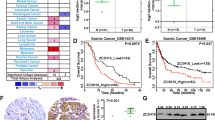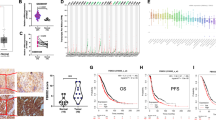Abstract
The pathophysiological mechanisms that drive the development and progression of epithelial ovarian cancer remain obscure. Recently, we identified TCEAL7 as a transcriptional regulatory protein often downregulated in epithelial ovarian cancer. However, the biological significance of such downregulation in cancer is not currently known. Here, we show that TCEAL7 is downregulated frequently in many human cancers and that in immortalized human ovarian epithelial cells this event promotes anchorage-independent cell growth. Mechanistic investigations revealed that TCEAL7 associates with cyclin D1 promoter containing Myc E-box sequence and transcriptionally represses cyclin D1 expression. Moreover, downregulation of TCEAL7 promotes DNA-binding activity of Myc-Max, and upregulates the promoter activity of c-Myc-target gene, ornithine decarboxylase (ODC), whereas enhanced expression of TCEAL7 inhibits Myc-induced promoter activity of ODC. Our findings suggest that TCEAL7 may restrict ovarian epithelial cell transformation by limiting Myc activity. These results also suggest a potential, alternative mechanism by which c-Myc activity may be deregulated in cancer by the downregulation of TCEAL7.
This is a preview of subscription content, access via your institution
Access options
Subscribe to this journal
Receive 50 print issues and online access
$259.00 per year
only $5.18 per issue
Buy this article
- Purchase on Springer Link
- Instant access to full article PDF
Prices may be subject to local taxes which are calculated during checkout






Similar content being viewed by others
References
Baudino TA, Cleveland JL . (2001). The Max network gone mad. Mol Cell Biol 21: 691–702.
Bell DA . (2005). Origins and molecular pathology of ovarian cancer. Mod Pathol 18 (Suppl 2): S19–S32.
Berns K, Hijmans EM, Mullenders J, Brummelkamp TR, Velds A, Heimerikx M et al. (2004). A large-scale RNAi screen in human cells identifies new components of the p53 pathway. Nature 428: 431–437.
Budhram-Mahadeo VS, Latchman DS . (2006). Targeting Brn-3b in breast cancer therapy. Expert Opin Ther Targets 10: 15–25.
Chien J, Aletti G, Baldi A, Catalano V, Muretto P, Keeney GL et al. (2006). Serine protease HtrA1 modulates chemotherapy-induced cytotoxicity. J Clin Invest 116: 1994–2004.
Chien J, Staub J, Avula R, Zhang H, Liu W, Hartmann LC et al. (2005). Epigenetic silencing of TCEAL7 (Bex4) in ovarian cancer. Oncogene 24: 5089–5100.
Chien J, Staub J, Hu SI, Erickson-Johnson MR, Couch FJ, Smith DI et al. (2004). A candidate tumor suppressor HtrA1 is downregulated in ovarian cancer. Oncogene 23: 1636–1644.
Chien J, Wong E, Nikes E, Noble MJ, Pantazis CG, Shah GV . (1999). Constitutive activation of stimulatory guanine nucleotide binding protein (G(S)alphaQL)-mediated signaling increases invasiveness and tumorigenicity of PC-3M prostate cancer cells. Oncogene 18: 3376–3382.
Conover CA, Hartmann LC, Bradley S, Stalboerger P, Klee GG, Kalli KR et al. (1998). Biological characterization of human epithelial ovarian carcinoma cells in primary culture: the insulin-like growth factor system. Exp Cell Res 238: 439–449.
Dalla-Favera R, Bregni M, Erikson J, Patterson D, Gallo RC, Croce CM . (1982). Human c-myc onc gene is located on the region of chromosome 8 that is translocated in Burkitt lymphoma cells. Proc Natl Acad Sci USA 79: 7824–7827.
Elliott K, Sakamuro D, Basu A, Du W, Wunner W, Staller P et al. (1999). Bin1 functionally interacts with Myc and inhibits cell proliferation via multiple mechanisms. Oncogene 18: 3564–3573.
Fernandez PC, Frank SR, Wang L, Schroeder M, Liu S, Greene J et al. (2003). Genomic targets of the human c-Myc protein. Genes Dev 17: 1115–1129.
Fukumoto M, Nakayama K . (2006). Ovarian epithelial tumors of low malignant potential: are they precursors of ovarian carcinoma? Pathol Int 56: 233–239.
Gillett C, Fantl V, Smith R, Fisher C, Bartek J, Dickson C et al. (1994). Amplification and overexpression of cyclin D1 in breast cancer detected by immunohistochemical staining. Cancer Res 54: 1812–1817.
Gomis RR, Alarcon C, Nadal C, Van Poznak C, Massague J . (2006). C/EBPbeta at the core of the TGFbeta cytostatic response and its evasion in metastatic breast cancer cells. Cancer Cell 10: 203–214.
Grandori C, Cowley SM, James LP, Eisenman RN . (2000). The Myc/Max/Mad network and the transcriptional control of cell behavior. Annu Rev Cell Dev Biol 16: 653–699.
Hall M, Peters G . (1996). Genetic alterations of cyclins, cyclin-dependent kinases, and Cdk inhibitors in human cancer. Adv Cancer Res 68: 67–108.
Jeon C, Agarwal K . (1996). Fidelity of RNA polymerase II transcription controlled by elongation factor TFIIS. Proc Natl Acad Sci USA 93: 13677–13682.
Kalli KR, Falowo OI, Bale LK, Zschunke MA, Roche PC, Conover CA . (2002). Functional insulin receptors on human epithelial ovarian carcinoma cells: implications for IGF-II mitogenic signaling. Endocrinology 143: 3259–3267.
Lamb J, Ramaswamy S, Ford HL, Contreras B, Martinez RV, Kittrell FS et al. (2003). A mechanism of cyclin D1 action encoded in the patterns of gene expression in human cancer. Cell 114: 323–334.
Massague J, Seoane J, Wotton D . (2005). Smad transcription factors. Genes & Development 19: 2783–2810.
Nesbit CE, Tersak JM, Prochownik EV . (1999). MYC oncogenes and human neoplastic disease. Oncogene 18: 3004–3016.
Nilsson JA, Keller UB, Baudino TA, Yang C, Norton S, Old JA et al. (2005). Targeting ornithine decarboxylase in Myc-induced lymphomagenesis prevents tumor formation. Cancer Cell 7: 433–444.
Orian A, van Steensel B, Delrow J, Bussemaker HJ, Li L, Sawado T et al. (2003). Genomic binding by the Drosophila Myc, Max, Mad/Mnt transcription factor network. Genes Dev 17: 1101–1114.
Oster SK, Ho CS, Soucie EL, Penn LZ . (2002). The myc oncogene: MarvelouslY complex. Adv Cancer Res 84: 81–154.
Shridhar V, Lee J, Pandita A, Iturria S, Avula R, Staub J et al. (2001). Genetic analysis of early- versus late-stage ovarian tumors. Cancer Res 61: 5895–5904.
Shridhar V, Sen A, Chien J, Staub J, Avula R, Kovats S et al. (2002). Identification of underexpressed genes in early- and late-stage primary ovarian tumors by suppression subtraction hybridization. Cancer Res 62: 262–270.
Staub J, Chien J, Pan Y, Qian X, Narita K, Aletti G et al. (2007). Epigenetic silencing of HSulf-1 in ovarian cancer: implications in chemoresistance. Oncogene 26: 4969–4978.
Taub R, Kirsch I, Morton C, Lenoir G, Swan D, Tronick S et al. (1982). Translocation of the c-myc gene into the immunoglobulin heavy chain locus in human Burkitt lymphoma and murine plasmacytoma cells. Proc Natl Acad Sci USA 79: 7837–7841.
Thomas MJ, Platas AA, Hawley DK . (1998). Transcriptional fidelity and proofreading by RNA polymerase II. Cell 93: 627–637.
Westbrook TF, Martin ES, Schlabach MR, Leng Y, Liang AC, Feng B et al. (2005). A genetic screen for candidate tumor suppressors identifies REST. Cell 121: 837–848.
Yeh CH, Shatkin AJ . (1995). A cis-acting element in Rous sarcoma virus long terminal repeat required for promoter repression by HeLa nuclear protein p21. J Biol Chem 270: 15815–15820.
Acknowledgements
This study was funded by Fraternal Order of Eagle to VS, by Department of Defense OCRP W81XWH-04-1-0085 to VS, and by Edith and Bernie Waterman Foundation and the Mayo Foundation to VS.
Author information
Authors and Affiliations
Corresponding author
Additional information
Supplementary Information accompanies the paper on the Oncogene website (http://www.nature.com/onc)
Supplementary information
Rights and permissions
About this article
Cite this article
Chien, J., Narita, K., Rattan, R. et al. A role for candidate tumor-suppressor gene TCEAL7 in the regulation of c-Myc activity, cyclin D1 levels and cellular transformation. Oncogene 27, 7223–7234 (2008). https://doi.org/10.1038/onc.2008.360
Received:
Revised:
Accepted:
Published:
Issue Date:
DOI: https://doi.org/10.1038/onc.2008.360
Keywords
This article is cited by
-
Transcription elongation factor A-like 7, regulated by miR-758-3p inhibits the progression of melanoma through decreasing the expression levels of c-Myc and AKT1
Cancer Cell International (2021)
-
Cancer-associated fibroblast-derived exosomal miR-18b promotes breast cancer invasion and metastasis by regulating TCEAL7
Cell Death & Disease (2021)
-
Downregulation of TCEAL7 expression induces CCND1 expression in non-small cell lung cancer
Molecular Biology Reports (2019)
-
Beta catenin and cytokine pathway dysregulation in patients with manifestations of the "PTEN hamartoma tumor syndrome"
BMC Medical Genetics (2012)
-
The elements of human cyclin D1 promoter and regulation involved
Clinical Epigenetics (2011)



